
“It’s hard to tell in the short term, but something could change.” The person speaking, who asked to remain anonymous, believes that the attacks on the city of Moscow could open up new scenarios. The Russian Defence Ministry confirmed that eight drones targeted civilian areas of the Moscow region. Five were shot down by the Pantsir-S surface-to-air missile system while the other two hit residential buildings in south-west Moscow. News reports are inconclusive: it appears that only two persons sought medical treatment and that no one was seriously injured.
“The fact that two residential areas of Moscow were hit by drones is a new development”.
As sadly happens in these cases, these incidents fall into oblivion and local public opinion has a hard time figuring out what exactly happened and whether the attacks were actually ‘terrorist attacks’ or whether they were ‘staged’. Moreover, more soldiers must be deployed on the battlefield and a second wave of mobilization swirl is likely to take place. The easiest way to make the population swallow this bitter pill is to stage terrorist attacks or proclaim the threat of a counter-attack from Ukraine.
A recent sociological study found that of all the popular sentiments recorded in Russian public opinion polls over the past year, shame or guilt over what is happening in Ukraine is conspicuous by its absence, while feelings of patriotism are on the rise. “I believe that in case of a war between France and Germany, each morning, every Italian citizen would be asking themselves some utterly serious questions and would feel involved,” the source noted.
“But here in Russia, social and political awareness or lack thereof is entirely different. Until now, the war was perceived as being something remote that concerns the government but not everyday life”, he said.
“On top of that, there is widespread emotional detachment and passivity vis a vis world events. People suffer and endure much more. Some also tend to say to themselves, “I can’t do anything about it” or “it’s not up to me”, besides the utter silence of the media. In this respect, we must not forget that the term ‘war’ is not allowed in the media. What is happening in Ukraine cannot yet be labelled as ‘war.”’
Such a dramatic incident had not been recorded in Russia to date. Last night’s drones were likewise detected and shot down. “No footage of destruction, fires or casualties has been released. Clearly, there are no strong enough psychological motivations for the population to respond as of yet.”
Similarly, the mobilization of the country’s military for the war in Ukraine was done in a very cunning manner, deliberately avoiding recruiting soldiers in Moscow and the big cities and sending out military summons in the more peripheral regions of the Federation.
What has become of the young people who took to the streets to voice their anti-Putin dissent? “Young people are still there, along with their discontent, except that taking to the streets implies exposing oneself to major risks,” the source replied. “The last protests were brutally repressed by the police and people still have vivid memories of it.” As a result, people are afraid. Thus, for now, it is highly unrealistic to expect people to take to the streets en masse. It depends on the prevailing factor. “If discontent prevails over fear, or if the fear of an external attack on Russian territory prevails, then we might start seeing people react. That’s why Moscow and the big cities were not involved in the large-scale mobilisation: for fear that the threshold of discontent could grow.”
“But the more the incidents continue, the harder it is to stop young people from protesting.”
A few days ago it was announced that Cardinal Matteo Zuppi would be undertaking a ‘peace mission’ to Kyiv and Moscow on behalf of Pope Francis. “Viewed through the eye of the man in the street – said the source – we must not have too many expectations. The mission should be understood against the backdrop of strong nationalism. There are no particular expectations as to what might happen. The Chinese were definitely followed more closely. However, it should be said that if a new scenario were to emerge, and if it involved extending the attacks on the large cities of the Russian Federation such as Moscow, then inevitably the people would start to wonder about what the church is doing in this context. The recent decision of the Patriarch and the ecclesiastical court of the Moscow diocese to suspend ad divinis and defrock a priest simply for having prayed for peace, is a stark reminder.
People will start wondering what the Church intends to do. Whether it will continue to pursue a strong policy of total support for the government, or whether a change of course is possible.”











